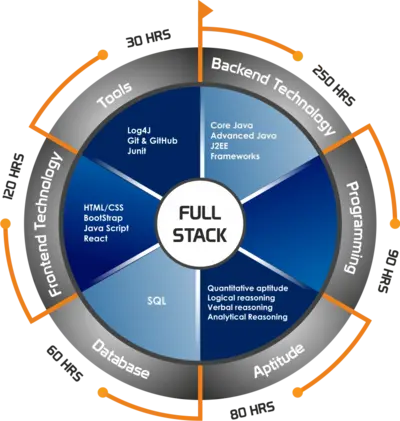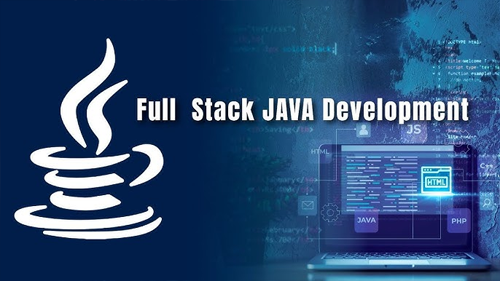Java Full Stack Course Details
This Advanced Java Full Stack Developers Course & Training is designed to guide you through the Main Concept of Java from Beginner to Advanced level of Techniques & skills. This Ultimate Java course & training will also provide you with the Knowledge of Core Java 8, Loops, Operators, Arrays, Constructors & Methods while also giving you real hand experience on project of JUNIT & JDBC frameworks.
What you’ll learn?
VeeraTraings with real time program to get an Hands on expossure where you can implement core business logic with multi layered applications.
Practical approachment on case studies , readiness for client requirements with respect to Banking,Telecom,Insurance,Helathcare
and eCommerce based applications.
You will learn multiple servers deployment factors on both web and application servers(Apache Tomcat,Weblogic and JBoss) More handson expossure with application programming interface.
Full stack application development with multiple domain based knowledge along with single page application models and controllers are the highlighting features.
VeeraTrainings coding influences more confidence in technological areas and becoming Brand Ambassador in Java.
Requirements
- Phasellus enim magna, varius et commodo ut, ultricies vitae velit. Ut nulla tellus, eleifend euismod pellentesque vel, sagittis vel justo
- Ultricies vitae velit. Ut nulla tellus, eleifend euismod pellentesque vel.
- Phasellus enim magna, varius et commodo ut.
- Varius et commodo ut, ultricies vitae velit. Ut nulla tellus.
- Phasellus enim magna, varius et commodo ut.
Services List
Enquire Now
JAVA FULL STACK DEVELOPER COURSE SYLLABUS
The curriculum of this program is designed to aid students in learning to gain knowledge through practical projects that make use of popular technologies such as Java, Java Script, Bootstrap, HTML, CSS and many more. Join the ranks of emerging full stack developers that use their expertise to discover the most effective patterns.
The curriculum of this program is designed to aid students in learning to gain knowledge through practical projects that make use of popular technologies such as Java, Java Script, Bootstrap, HTML, CSS and many more. Join the ranks of emerging full stack developers that use their expertise to discover the most effective patterns.

JAVA FULL STACK COURSE CONTENTS
- Introduction to Java
- Java Virtual Machine(JVM) Basics
- First Java Program
- Variables in Java
- Java Data Types
- Java Operators
- If-else in Java
- Switch-Case in Java
- Java For loop
- Java While loop
- do-while loop in Java
- Java Continue statement
- Java Break statement
- Constructor in Java
- Static keyword in Java
- Java Inheritance with example
- Types of inheritance in Java
- Aggregation in Java
- Association in Java
- Super Keyword in Java
- Method overloading in Java
- Method overriding in Java
- Java – Method Overloading vs Method Overriding
- Polymorphism in Java
- Types of polymorphism in Java
- Static and dynamic binding
- Abstract class in Java
- Java Abstract method with example
- Interface in Java
- Java – Abstract class vs interface
- Java Encapsulation with example
- Java Packages with examples
- Access modifiers in Java
- Garbage Collection in Java
- final keyword
- Java Exception handling
- Java try-catch block
- Java finally block
- How to throw exception in Java
- Custom Exception in Java
- Exception Examples
- Java Collections
- Java ArrayList
- Java LinkedList
- Vector in Java
- HashMap in Java
- Java TreeMap
- Java LinkedHashMap
- Java HashSet
- TreeSet in Java
- LinkedHashSet
- Hashtable in Java
- Queue
- PriorityQueue
- Deque & ArrayDeque
- Comparable Interface
- Comparator Interface
- Multithreading in Java
- Serializtion in java
- Java Lambda Expressions
- Java Method References
- Java Functional Interfaces
- Java Stream
- Java Stream Filter
- Java Interface changes
- Java forEach
- Java Stream Collectors class
- Java StringJoiner class
- Java Optional class
- Java Arrays Parallel Sort
- MySQL Overview
- Basics of Relational Databases
- Entities and Relationships
- SQL Language and MySQL
- SQL DDL AND DML
- MySQL Client/Server Model
- MySQL Connectors
- Database Modeling
- Keys and Normalization
- Database Design
- Viewing and Evaluating a Database
- Data Types and Database Design
- Numeric and String Data Types
- Creating a Database
- Creating a Table
- Showing How a Table Was Created
- Table Options
- Column Options
- Indexes, Keys, and Constraints
- Deleting database and tables
- Creating New Table Using an Existing Table
- Creating a Temporary Table
- Copying an Existing Table Structure
- Adding, removing and modifying table columns and indexes
- The SELECT Statement
- Creating Views
- Querying Data from an Application
- Manipulating Data and inserting records
- Replacing and updating existing records
- Deleting records
- Exporting and importing a script
- Modifying Data from an Application
- Querying Multiple Tables
- Joining Tables with SELECT
- Inner Joins
- Outer Joins
- Table Name Aliases
- Functions in MySQL Expressions
- Using Functions
- String Functions
- Date and time functions
- Numeric Functions
- Aggregate Functions
- Spaces in Function Names
- Understanding Backups & Backup Techniques
- Creating a Backup Strategy
- MySQL Backup Tools
- Raw Backup Methods
- Driver interface
- Connection interface
- Statement interface
- PreparedStatement interface
- CallableStatement interface
- ResultSet interface
- ResultSetMetaData interface
- DatabaseMetaData interface
- RowSet interface
- Classes of JDBC API
- A list of popular classes of JDBC API is given below:
- CRUD Operation
- SDLC
- Software Development Life Cycle
- Models
- Waterfall Model
- Agile Model
- Big Bang Model
- Fish Model
- Hybrid Model
- Incremental Model
- Iterative Model
- JAD Model
- Prototype Model
- RAD Model
- Spiral Model
- V Model
- SMALL PROJECT WHICH INLUCDES WHATEVER WE HAVE LEARNED SO FAR
- Software Testing
- Software Testing - Myths
- Software Testing - QA, QC & Testing
- Software Testing - ISO Standards
- Software Testing - Types of Testing WILL UNDERSTAND TESTING
- JUnit - Overview
- JUnit - Environment Setup
- JUnit - Test Framework
- JUnit - Basic Usage
- JUnit - API
- JUnit - Writing a Tests
- JUnit - Using Assertion
- JUnit - Execution Procedure
- JUnit - Executing Tests
- JUnit - Suite Test
- JUnit - Ignore Test
- JUnit - Time Test
- JUnit - Exceptions Test
- JUnit - Parameterized Test
- JUnit - Plug with Ant
- JUnit - Plug with Eclipse
- JUnit - Extensions
- SPRING CONTENTS
- Spring - Overview
- Spring - Architecture
- Spring - Hello World Example
- Spring - IoC Containers
- Spring - Bean Definition
- Spring - Dependency Injection
- Spring - Injecting Inner Beans
- Spring - Injecting Collection
- Spring - Beans Auto-Wiring
- Annotation Based Configuration
- Spring - Java Based Configuration
- Spring - AOP with Spring Framework
- Spring - JDBC TEMPLATE
- Html,CSS,Javascript
- SPRING MVC
- Spring MVC - Overview
- Spring MVC - Environment Setup
- Spring MVC - Hello World Example
- Spring MVC - Form Handling
- Spring MVC - Form Handling
- Spring MVC - Page Redirection
- Spring MVC - Static Pages
- Spring MVC - Form Tag library
- Spring MVC - Textbox
- Spring MVC - Password
- Spring MVC - Textarea
- Spring MVC - Checkbox
- Spring MVC - Checkboxes
- Spring MVC - Radiobutton
- Spring MVC - Radiobuttons
- Spring MVC - Dropdown
- Spring MVC - Listbox
- PROJECT WEB BASED (CAPSTONE PROJECT)
- What is a Web Service?
- Advantages of Web Services
- Types of Web Services
- Soap Web Service
- Rest Web Service
- JAX-WS API Example
- JAX-RS API Example
- Create RESTful API's USING SPRING
- Monolithic Architecture
- Distributed Architecture
- Service oriented Architecture
- Microservice and API Ecosystem
- Microservices in nutshell
- Point of considerations
- SOA vs. Microservice
- Microservice & API
- Making Microserice in spring
- Unix / Linux - File Management
- Unix / Linux - Directories
- Unix / Linux - File Permission
- Unix / Linux - Environment
- Unix / Linux - Basic Utilities
- Unix / Linux - Pipes & Filters
- Unix / Linux - Processes
- All basic Commands
- Jenkins - Overview
- Jenkins - Installation
- Jenkins - Tomcat Setup
- Jenkins - Git Setup
- Jenkins - Maven Setup
- Jenkins - Configuration
- Jenkins - Management
- Jenkins - Setup Build Jobs
- Jenkins - Unit Testing
- Jenkins - Automated Testing
- Jenkins - Notification
- Jenkins - Reporting
- Jenkins - Code Analysis
- Jenkins - Distributed Builds
- Jenkins - Automated Deployment
- Jenkins - Metrics and Trends
- Jenkins - Server Maintenance
- Jenkins - Continuous Deployment
- Jenkins - Managing Plugins
- Jenkins - Security
- What is Git?
- How does Git work?
- Branches
- Commits
- What are the benefits of Git?
- Collaboration with GitHub
- Basic Commands
- Git - Home
- Git - Basic Concepts
- Git - Environment Setup
- Git - Life Cycle
- Git - Create Operation
- Git - Clone Operation
- Git - Perform Changes
- Git - Review Changes
- Git - Commit Changes
- Git - Push Operation
- Git - Update Operation
- Git - Stash Operation
- Git - Move Operation
- Git - Rename Operation
- Git - Delete Operation
- Git - Fix Mistakes
- Git - Tag Operation
- Git - Patch Operation
- Git - Managing Branches
- Git - Handling Conflicts
- Git - Different Platforms
- Git - Online Repositories
- What is Cloud Computing?
- History of Cloud Computing
- Why is Cloud Computing popular?
- Characteristics of Cloud Computing
- Benefits of Cloud Computing
- Cloud Computing Architecture
- Types of Clouds
- Public Cloud
- Private Cloud
- Hybrid Cloud
- Community Cloud
- Cloud Computing Services
- SaaS
- PaaS
- IaaS
- Demo for AWS

